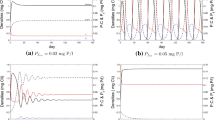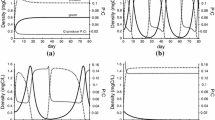Abstract
Various environmental conditions may exert selection pressures leading to adaptation of stoichiometrically important traits, such as organismal nutritional content or growth rate. We use theoretical approaches to explore the connections between genotypic selection and ecological stoichiometry in spatially heterogeneous environments. We present models of a producer and two grazing genotypes with different stoichiometric phosphorus/carbon ratios under spatially homogenous and heterogeneous conditions. Numerical experiments predict that selection of a single genotype, co-persistence of both genotypes, and extinction are possible outcomes depending on environmental conditions. Our results indicated that in spatially homogenous settings, co-persistence of both genotypes can occur when population dynamics oscillate on limit cycles near a key stoichiometric threshold on food quality. Under spatially heterogeneous settings, dynamics are more complex, where co-persistence is observed on limit cycles, as well as stable equilibria.







Similar content being viewed by others
Notes
Link url to supplementary materials.
References
Abrams PA (2000) The evolution of predator-prey interactions: theory and evidence. Ann Rev Ecol Syst 31(1):79–105
Andersen T (1997) Pelagic nutrient cycles; herbivores as sources and sinks. Springer, Berlin
Andersen T, Elser JJ, Hessen DO (2004) Stoichiometry and population dynamics. Ecol Lett 7(9):884–900
Ascher UM, Petzold LR (1998) Computer methods for ordinary differential equations and differential-algebraic equations, vol 61. SIAM, Philadelphia
Barry RG, Chorley RJ (2003) Atmosphere. Weather and climate. Routledge, London
Bird RB, Stewart WE, Lightfoot EN (2004) Transport phenomena. 2002. Wiley, New York
Cantrell RS, Cosner C, Lou Y (2010a) Evolution of dispersal in heterogeneous landscapes. In: Cantrell S, Cosner C, Ruan S (eds) Spatial Ecology. CRC Press, Taylor & Francis Group, pp 213–229
Cantrell S, Cosner C, Ruan S (2010b) Spatial Ecology. CRC Press, Taylor & Francis Group
Dissanayake C (2016) Finite element simulation of space/time behavior in a two species ecological stoichiometric model. Ph.D. thesis, Texas Tech University
Elser J (2006) Biological stoichiometry: a chemical bridge between ecosystem ecology and evolutionary biology. Am Nat 168(S6):S25–S35
Gresho PM, Sani RL (1998) Incompressible flow and the finite element method. Volume 1: advection–diffusion and isothermal laminar flow. Wiley, New York
Grover JP (2004) Predation, competition, and nutrient recycling: a stoichiometric approach with multiple nutrients. J Theor Biol 229(1):31–43
Hanski I (2010) Incorporating the spatial configuration of the habitat into ecology and evolutionary biology. In: Cantrell S, Cosner C, Ruan S (eds) Spatial Ecology. CRC Press, Taylor & Francis Group, pp 167–188
Heroux MA, Bartlett RA, Howle VE, Hoekstra RJ, Hu JJ, Kolda TG, Lehoucq RB, Long KR, Pawlowski RP, Phipps ET, Salinger AG, Thornquist HK, Tuminaro RS, Willenbring JM, Williams A, Stanley KS (2005) An overview of the Trilinos project. ACM Trans Math Softw 31(3):397–423. https://doi.org/10.1145/1089014.1089021
Hessen DO, Elser JJ, Sterner RW, Urabe J (2013) Ecological stoichiometry: an elementary approach using basic principles. Limnol Oceanogr 58(6):2219–2236
Holt RD, Barfield M (2010) Metapopulation perspectives on the evolution of species’ niches. In: Cantrell S, Cosner C, Ruan S (eds) Spatial Ecology. CRC Press, Taylor & Francis Group, pp 188–211
Huisman J, Sharples J, Stroom JM, Visser PM, Kardinaal WEA, Verspagen JM, Sommeijer B (2004) Changes in turbulent mixing shift competition for light between phytoplankton species. Ecology 85(11):2960–2970
Imboden DM, Wüest A (1995) Mixing mechanisms in lakes. Physics and chemistry of lakes. Springer, Berlin, pp 83–138
Johnson C (2012) Numerical solution of partial differential equations by the finite element method. Courier Corporation
Kay AD, Ashton IW, Gorokhova E, Kerkhoff AJ, Liess A, Litchman E (2005) Toward a stoichiometric framework for evolutionary biology. Oikos 109(1):6–17
Kelley CT (2003) Solving nonlinear equations with Newton’s method. SIAM, Philadelphia
Kirk JT (1994) Light and photosynthesis in aquatic ecosystems. Cambridge University Press, Cambridge
Kuefler D, Avgar T, Fryxell JM (2012) Rotifer population spread in relation to food, density and predation risk in an experimental system. J Anim Ecol 81(2):323–329
Kuefler D, Avgar T, Fryxell JM (2013) Density-and resource-dependent movement characteristics in a rotifer. Funct Ecol 27(2):323–328
Loladze I, Kuang Y, Elser JJ (2000) Stoichiometry in producer-grazer systems: linking energy flow with element cycling. Bull Math Biol 62(6):1137–1162
Loladze I, Kuang Y, Elser JJ, Fagan WF (2004) Competition and stoichiometry: coexistence of two predators on one prey. Theor Popul Biol 65(1):1–15
Long K, Kirby R, van Bloemen Waanders B (2010) Unified embedded parallel finite element computations via software-based Fréchet differentiation. SIAM J Sci Comput 32(6):3323–3351
Lorke A (1998) Investigation of turbulent mixing in shallow lakes using temperature microstructure measurements. Aquat Sci Res Across Bound 60(3):210–219
Meng X, Zhang L (2016) Evolutionary dynamics in a Lotka–Volterra competition model with impulsive periodic disturbance. Math Methods Appl Sci 39(2):177–188
Metz JA, Nisbet RM, Geritz SA (1992) How should we define ‘fitness’ for general ecological scenarios? Trends Ecol Evol 7(6):198–202
Moody EK, Rugenski AT, Sabo JL, Turner BL, Elser JJ (2017) Does the growth rate hypothesis apply across temperatures? variation in the growth rate and body phosphorus of neotropical benthic grazers. Front Environ Sci 5:14
Morozov A, Kuzenkov O (2016) Towards developing a general framework for modelling vertical migration in zooplankton. J Theor Biol 405:17–28
Peace A (2015) Effects of light, nutrients, and food chain length on trophic efficiencies in simple stoichiometric aquatic food chain models. Ecol Model 312:125–135
Peace A, Zhao Y, Loladze I, Elser JJ, Kuang Y (2013) A stoichiometric producer-grazer model incorporating the effects of excess food-nutrient content on consumer dynamics. Math Biosci 244:107
Peace A, Wang H, Kuang Y (2014) Dynamics of a producer-grazer model incorporating the effects of excess food nutrient content on grazer’s growth. Bull Math Biol 76(9):2175–2197
Rana M, Dissanayake C, Juan L, Long K, Peace A (2019) Mechanistically derived heterogeneous producer-grazer model, subject to stoichiometric constraints. Math Biosci Engg 16(1):222–233. https://doi.org/10.3934/mbe.2019012
Sala M, Stanley K, Heroux M (2006) Amesos: a set of general interfaces to sparse direct solver libraries. In: Proceedings of PARA’06 conference, Umea, Sweden
Shu FH (1991) The physics of astrophysics, vol. 2: radiation. University Science Books, Mill Valley
Sterner RW, Elser JJ (2002) Ecological stoichiometry: the biology of elements from molecules to the biosphere. Princeton University Press, Princeton
Wang H, Kuang Y, Loladze I (2008) Dynamics of a mechanistically derived stoichiometric producer-grazer model. J Biol Dyn 2(3):286–296
Wang H, Sterner RW, Elser JJ (2012) On the “strict homeostasis” assumption in ecological stoichiometry. Ecol Model 243:81–88
Weider LJ, Makino W, Acharya K, Glenn KL, Kyle M, Urabe J, Elser JJ (2005) Genotype \(\times \) environment interactions, stoichiometric food quality effects, and clonal coexistence in Daphnia pulex. Oecologia 143(4):537–547
Yamamichi M, Meunier CL, Peace A, Prater C, Rúa MA (2015) Rapid evolution of a consumer stoichiometric trait destabilizes consumer–producer dynamics. Oikos 124(7):960–969
Author information
Authors and Affiliations
Corresponding author
Additional information
Publisher's Note
Springer Nature remains neutral with regard to jurisdictional claims in published maps and institutional affiliations.
Electronic supplementary material
Below is the link to the electronic supplementary material.
Supplementary material 1 (mp4 10700 KB)
Supplementary material 2 (mp4 10237 KB)
Supplementary material 3 (mp4 11373 KB)
Supplementary material 4 (mp4 9422 KB)
Supplementary material 5 (mp4 11295 KB)
Supplementary material 6 (mp4 6742 KB)
Rights and permissions
About this article
Cite this article
Dissanayake, C., Juan, L., Long, K.R. et al. Genotypic Selection in Spatially Heterogeneous Producer-Grazer Systems Subject to Stoichiometric Constraints. Bull Math Biol 81, 4726–4742 (2019). https://doi.org/10.1007/s11538-018-00559-9
Received:
Accepted:
Published:
Issue Date:
DOI: https://doi.org/10.1007/s11538-018-00559-9




